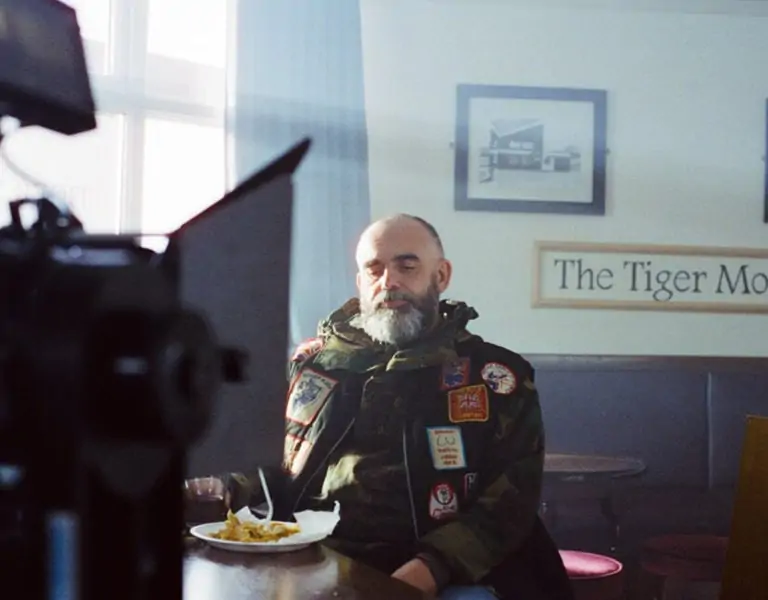
Cinematographer Zach Kuperstein was tapped by Boulderlight Pictures to lens the 2022 hit horror-thriller Barbarian, directed by Zach Cregger.
The film follows the sinister happenings at and under 476 Barbary Street in a downtrodden neighborhood in the outskirts of Detroit. The genre-twisting narrative opens as Tess Marshall (Georgina Campbell) arrives to find a suspicious stranger (Bill Skarsgård as Keith Toshko) staying in her Air BNB. There’s more than poor management afoot and after unearthing a hidden underground tunnel, things go from bad to worse. Just as it seems Tess will disappear without a trace, AJ Gilbride (Justin Long), a ne’er-do-well Hollywood celebrity, arrives on the scene to take stock of his Michigan properties, including the house on Barbary.
It was no small undertaking to re-create the burned-out suburbs of Detroit in Bulgaria, where the film was set to shoot. “I had never been to Detroit,” says Kuperstein. “Looking at the reference photos, I was shocked. I didn’t know that there was an area that existed like that.” Production Designer Rossitsa Bakeva dived enthusiastically into bringing the desolated setting of the film to life. Abandoned run-down houses crowd to either side of the hero house, which is jarringly well-maintained. “Finally, a few months later we ended up going to Detroit. Driving around the streets, I was relieved to see that we had actually kind of nailed it.”
Barbarian was Kuperstein’s first time shooting with the Sony VENICE I. “I’d never used the VENICE but I’d heard rave reviews from other DPs. I needed it for low light, shooting at 2,500 ISO without concern. I also wanted fast lenses to pair with it, considering all the stuff in the tunnels, lit only with flashlights.” He decided on the ZEISS Supreme Primes and a CP.3 to accommodate the large format sensor and low-light requirements. “I wanted fast lenses, and I wanted it to be sharp and present and feel different from other work that I’ve done.”
The camera package came from Magic Shop Rentals in Bulgaria; however, the rental house did not have the 18mm or 21mm Supreme Primes. Because of the film’s many wide-wide angle shots and scenes, there was no way he could shoot the film without going wider than his Supreme Prime 25mm. After testing several other lenses, they offered Kuperstein the 15mm CP.3 ZEISS. “That hit the mark for a 15mm, and it turned out to be really helpful because we needed that lightweight lens to shoot with the gimbal later on.”
In the past, Kuperstein had often opted for vintage lenses or lenses with unusual characteristics, but on Barbarian the Supreme Primes were just what he wanted. “I think it’s all about the closeups and just the presence of the lens and sharpness and how clean it is. There’s nothing between the viewer and the image. In Barbarian I wanted it to be very direct and what you see is what you get. These lenses did a great job of that.” He elaborates, “It was really nice to have low distortion and the clean lines of the stairs going up.”
The two Zachs approached the look of the film by emphasizing the three distinct environments: upstairs, downstairs and the flashback. “The upstairs should feel like a David Fincher movie, and the downstairs should feel like a Sam Raimi movie. That meant upstairs had very controlled, deliberate camera movement, consistently building suspense. There’s a lot of tension in the air. But downstairs its fast-paced, almost ridiculous. The camera movement is over the top.” Then for the memorable flashback sequence, the filmmakers created stylized, extremely wide-angled shots, very distinct from the rest of the movie.
“For lighting, I often look at Roger Deakins’ work. Prisoners has a lot of good flashlight work in it. When Jake Gyllenhaal’s character goes into the basement with the priest, I love the way the flashlight is creating a silhouette, then highlighting something and revealing things.” Eerie flashlight lighting characterizes the horror of Barbarian’s underground tunnels. Fast lenses were key to his approach. “I was a little worried to bring the Supreme Primes to Zach [Cregger] because they don’t flare that much. But he said, ‘I don’t want any flares from the flashlight. That’s too much.’ With the Supremes, there’s minimal flaring, so it was nice to be able to have control of that and keep it very, very clean and pristine.”
The CP.3 15mm also came in handy in unanticipated ways. Kuperstein describes using the Rialto with it. “We did some of the stuff in the underground pit with the Rialto because it was pretty tight, and the handheld operating required fast moves.” Other notably tight spaces included the various car work, especially in the flashback sequence. “The Rialto is still kind of big and heavy, so balancing it with the Ronin RS 2 was a challenge. In one scene, we needed to pass the camera through a narrow car window.” His team improvised a way to hold the RS 2 sideways and coordinated a delicate handoff, where the camera started stationary on a set of apple boxes before being lifted by the operator and passed through the car window to Kuperstein inside. “Because the operator was cabled to the camera, he had to sit on the windowsill and the best boy grip held him against the car as it started to drive. I’m just very grateful that that lens was tiny and that it all balanced.”
Barbarian is an undeniable success, grossing $45 million at the box office against a $4.5 million budget. With a surprising script, filled with cinematic twists and turns, Kuperstein calls it, “a horror movie for people who don’t necessarily like horror movies.”












